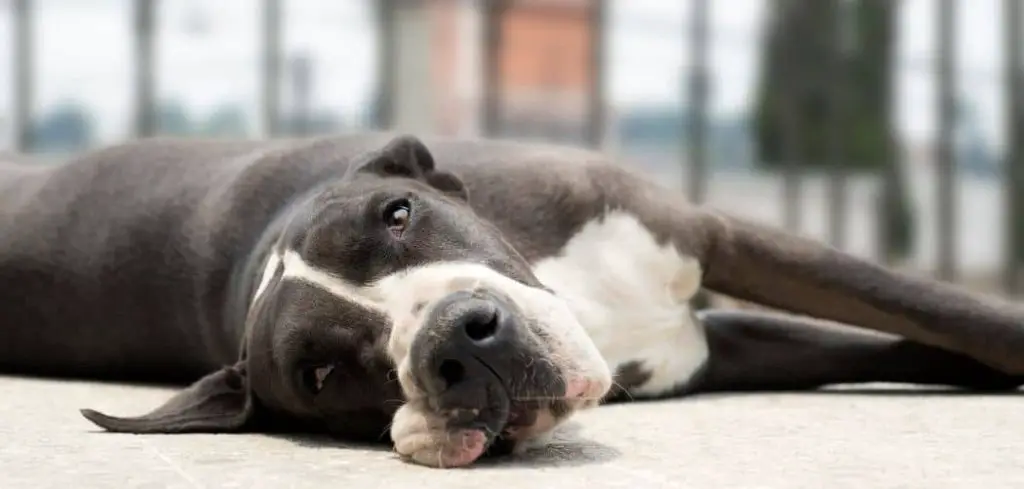When a dog is panting but reluctant or unable to move, it can be alarming. This combination of symptoms often points to discomfort or underlying medical issues that require attention.
We outline the common reasons why a dog may pant and not move, what you can do, and when to seek veterinary help.
Dog Panting and Not Moving — Why It Happens
Dog panting paired with refusal to move is a red flag for serious issues like pain, injury, heatstroke, or illness. Dogs may pant to cope with stress or discomfort while staying still to avoid worsening their condition. If your dog is panting heavily and unwilling to move, seek veterinary help immediately.

Dog Panting and Not Moving: Common Causes
Pain or Injury
Pain is one of the leading causes of a dog panting and not moving. Dogs in discomfort often avoid walking or standing, opting to lie down while still exhibiting signs of distress such as rapid breathing or whining.
Arthritis, muscle strains, joint injuries, and spinal problems can all lead to immobility and panting.
You may notice difficulty rising, limping, or sensitivity to touch. Prompt veterinary evaluation is crucial, as untreated pain can worsen and significantly reduce quality of life.
Read more: Dog Panting and Just Laying Around (Could signal underlying illness)
Heatstroke or Overheating
Overheating can cause a dog to pant excessively and become immobile. Dogs exposed to high temperatures, direct sunlight, or inadequate ventilation may become lethargic and unresponsive while still panting heavily.
Other warning signs include drooling, red gums, a fast heartbeat, and dizziness. Immediate action, such as moving the dog to a cooler area, offering water, and seeking emergency veterinary care, is essential to prevent organ damage or life-threatening complications.
Heart or Respiratory Problems
Heart and respiratory conditions often present as panting paired with reduced movement.
Dogs suffering from heart disease, congestive heart failure, or respiratory infections may become too weak to move while struggling to breathe.
Symptoms can include coughing, difficulty lying down, fatigue, and blue-tinged gums or tongue. Early detection and treatment are critical to manage these conditions and improve your dog’s comfort.
Hypoglycemia (Low Blood Sugar)
A sudden drop in blood sugar can make a dog pant and unable to move. This is especially common in small breeds, puppies, or dogs with metabolic disorders.
Other signs include trembling, weakness, confusion, and even collapse. Providing a small amount of sugar or honey in emergencies and contacting your veterinarian immediately can stabilize the dog while ensuring proper diagnosis and treatment.
Shock or Trauma
Trauma or shock can result in panting and immobility. Dogs experiencing internal injuries, severe allergic reactions, or blood loss may exhibit these symptoms alongside pale gums, rapid heartbeat, or cold extremities.
Shock is a life-threatening emergency that requires immediate veterinary intervention. Keeping the dog calm and minimizing movement while seeking emergency care is crucial.
Kidney or Liver Problems
Serious internal organ issues, such as kidney or liver disease, can lead to panting and lethargy.
Dogs may remain in one position, unable to move, while experiencing discomfort or systemic illness.
Accompanying signs include vomiting, diarrhea, unusual urination patterns, jaundice, or loss of appetite. Timely veterinary assessment is essential to diagnose and manage these conditions effectively.
Neurological Issues
Neurological problems, such as seizures, strokes, or spinal cord injuries, can cause panting and immobility. Dogs may appear disoriented, weak, or unable to control limb movement.
Other symptoms can include head tilting, loss of coordination, or sudden collapse. Immediate veterinary evaluation is critical to determine the underlying cause and prevent further complications.
What to Do If Your Dog Is Panting and Not Moving
Monitor your dog closely for any signs of injury, illness, or distress. Check for visible wounds, swelling, or areas of tenderness.
Ensure your dog is in a comfortable position and provide access to water. Avoid forcing movement, as this may worsen injuries or stress.
Keep your dog calm by speaking softly and minimizing environmental stressors. Dim lights or move the dog to a quiet room to reduce anxiety.
Provide gentle warmth if the dog is cold or shivering, but ensure the environment is not overheated.
Contact your veterinarian promptly for guidance, especially if the panting is severe, persistent, or accompanied by other concerning symptoms. Follow their advice for at-home care or emergency intervention.
When to Call or Visit Your Vet
Immediate veterinary attention is necessary if your dog exhibits any of the following:
Persistent or worsening panting with immobility
Signs of severe pain, trauma, or injury
Pale, blue, or jaundiced gums
Collapse, confusion, or seizures
Vomiting, diarrhea, or inability to eat or drink
Rapid heartbeat, labored breathing, or extreme lethargy
Early assessment can identify serious medical conditions and ensure timely treatment to protect your dog’s health and well-being.
Read more: Panting and Moving Around (Here’s why)
Key Takeaway
Panting combined with reluctance or inability to move is often a sign of pain, injury, internal illness, or severe stress.
While occasional immobility may occur after exercise or excitement, persistent symptoms require careful monitoring and prompt veterinary attention.
Creating a calm environment, observing for additional warning signs, and following professional guidance can help your dog recover safely and comfortably.
